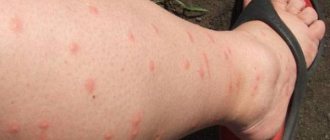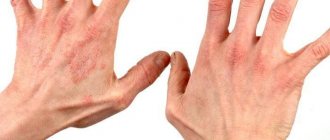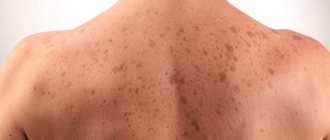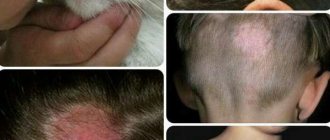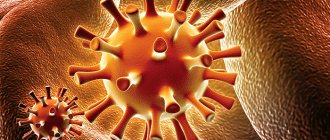Standard symptoms of chickenpox compared to other diseases
Chickenpox goes through several stages with characteristic symptoms:
- The incubation period from exposure to first symptoms is the longest of all infections, ranging from 10 to 21 days.
- The prodromal period from the first symptoms to the onset of rashes lasts from several hours to a day. General deterioration of the condition: fever and chills, headache and weakness, as in all diseases. Following this, red spots appear throughout the body, quickly turning into papules, very similar to other infectious diseases.
- Acute period - high temperature (up to 38.5 ° C and above) at the peak of the rash, there can be 2-3 waves, and each is accompanied by a new rise in temperature, then a decrease for 1-2 days between waves, unlike all other diseases in which the temperature remains consistently high or rises in the evening and at night.
- Itching from a rash is present in almost any disease, its degree depends on the individual sensitivity of the body.
- The rash quickly develops from a spot, first into a papule (bump), then into a single-chamber watery vesicle (vesicle) with a red rim - this is a typical element of a chickenpox rash. Such pimples or blisters form a few hours after the spots appear or the next day. This is how chickenpox is recognized.
- Then the blisters dry out, turn into crusts and disappear without a trace. Recovery occurs when the last scab falls off, after 3-5 days.
- The main difference from other infections is the picture of polymorphism of the chickenpox rash, when due to the waves all elements are visible simultaneously - spots, papules, vesicles and crusts. With any other infection, the rash occurs simultaneously, the picture is homogeneous.
As you can see, there are cases when acne appears like chickenpox, but not chickenpox, and it is necessary to differentiate them.
Many people know what chickenpox looks like; this can be understood by the appearance of characteristic rashes all over the body.
- The incubation period from exposure to first symptoms is the longest of all infections, ranging from 10 to 21 days.
- The prodromal period from the first symptoms to the onset of rashes lasts from several hours to a day. General deterioration of the condition: fever and chills, headache and weakness, as in all diseases. Following this, red spots appear throughout the body, quickly turning into papules, very similar to other infectious diseases.
- Acute period - high temperature (up to 38.5 o C and above) at the peak of the rash, there can be 2-3 waves, and each is accompanied by a new rise in temperature, then a decline for 1-2 days between waves, unlike all other diseases, in which the temperature remains consistently high or rises in the evening and at night.
- Itching from a rash is present in almost any disease, its degree depends on the individual sensitivity of the body.
- The rash quickly develops from a spot, first into a papule (bump), then into a single-chamber watery vesicle (vesicle) with a red rim - this is a typical element of a chickenpox rash. Such pimples or blisters form a few hours after the spots appear or the next day. This is how chickenpox is recognized.
- Then the blisters dry out, turn into crusts and disappear without a trace. Recovery occurs when the last scab falls off, after 3-5 days.
- The main difference from other infections is the picture of polymorphism of the chickenpox rash, when due to the waves all elements are visible simultaneously - spots, papules, vesicles and crusts. With any other infection, the rash occurs simultaneously, the picture is homogeneous.
https://www.youtube.com/watch?v=31CBJ1w06pA
Many people know what chickenpox looks like; this can be understood by the appearance of characteristic rashes all over the body.
Smallpox as one of the reasons
This disease is considered one of the most terrible and dangerous in the world. Nowadays, thanks to treatment and vaccinations, outbreaks of infection rarely occur in the world. Virus samples are kept only in special storage facilities in Russia and the USA. Chickenpox used to be considered a mild form of smallpox, but later scientists and doctors discovered many more differences. It has now been proven that chickenpox (chickenpox) is a completely different disease.
Smallpox raged strongly at different periods of history. The countries that suffered most from it were China, Africa, and India. This viral disease is transmitted through household items and by airborne droplets. The virus is very resistant to environmental conditions: in severe frost or heat, it lives for up to a year and can even withstand drought. After the death of an infected person, the virus remained on the dried wounds, so the bodies were burned.
The main symptoms of the disease are:
- blisters on the body and red spots;
- crusts that remained from burst blisters;
- fever and heat;
- wounds and ulcers.
Every two weeks the situation worsened, accompanied by waves of severe pain. When purulent wounds appeared on the body, it meant that the patient would soon die if treatment was not started.
All children are vaccinated to prevent smallpox. To treat this disease, drugs such as immunoglobulin and metisazone have been developed.
Principles of diagnosing infection
Chickenpox is also diagnosed by external, physical signs during a medical examination. Once your child has red pimples on the body, as well as all other signs of chickenpox that can be distinguished from prickly heat, you need to call a medical facility and consult with a specialist on further actions and treatment. If you feel unwell, complain about headaches, or fatigue, you should see a specialist.
Citizens who are at high risk of infection with the causative virus (a pregnant woman who has not had chickenpox before, people who have a weakened immune system, although they have had chickenpox before) are required to be examined for the presence of immunity developed against it. If they have not encountered the disease before, they are recommended to get vaccinated and increase the likelihood of not getting sick or catching it.
At the early stage of smallpox infection, you can treat yourself, but still do not neglect consulting a doctor.
Of course, any disease must be treated and, it seems, chicken pox is no exception. The main thing is to cure the skin so that pus does not accumulate in the blisters under the skin and pustules do not form. Zelenka is an excellent antiseptic with fast-acting disinfecting properties. This is indispensable in the treatment of illness.
When the body temperature rises, when the ability to tolerate it ends, they drink antipyretics in the form of syrup or tablets. Once you decide to wash yourself, you should not use rough washcloths, just pour some water over your body and add a weak solution of chamomile or potassium permanganate. Under no circumstances should you allow the body to be scratched, so as not to leave small scars.
If an adult is sick or children are sick, the local pediatrician or infectious disease doctor must visit them. A pediatrician treats children and adolescents aged 0 to 16 years. An infectious disease specialist treats infectious diseases, determines the congenital or acquired nature of the disease, diagnoses the causative agents of diseases, searches for the source of the disease, prescribes appropriate treatment and gives recommendations to those who have been ill.
After consulting a doctor, confirming the exact diagnosis and prescribing appropriate treatment, carefully monitor your health condition. If complications develop, you may be referred to an appointment with a pulmonologist who treats the bronchopulmonary system and respiratory system of those who have had chickenpox.
Chickenpox in its typical course should be differentiated from a disseminated form of herpes, herpes zoster, enterovirus infection and sudden exanthema. In official guidelines you can find a clause stating that chickenpox should be distinguished from smallpox, however, at present, cases of this dangerous infection are casuistry.
We suggest you read: How to protect an adult from chickenpox
Differential diagnosis is carried out on the basis of:
- Epidemiological history. The doctor examines the vaccination card data, determines whether there was possible contact with infectious patients or with an allergen (food, pollen, detergents), and walks down the street without using repellents.
- Visual inspection. The localization and nature of the rash on the skin, damage to the mucous membranes, nails, and lymph nodes are studied.
The erased form of chickenpox should be distinguished from measles, rubella, bacterial impetigo, allergic reactions and even insect bites. The final diagnosis is made based on:
- Anamnesis data.
- Determining how long ago the child was ill and how the disease developed.
- On what day did the rash appear, the stages of its appearance.
It is especially important to carry out differential diagnosis of the disease in persons with immune pathologies, patients with immunosuppression, pregnant women and women planning pregnancy.
To determine an accurate diagnosis, additional research methods are used:
- Isolation of the virus from the liquid of the vesicles (by PCR or propagation in cell culture).
- Determination of antigens to the herpes zoster virus (by direct immunofluorescence in scrapings from the bottom of the vesicle).
- Serological. Determination of antibody titer by ELISA.
The need for wound treatment
It is necessary to smear chickenpox to eliminate the risk of infection and prevent the baby from scratching the inflammation. In order to prevent negative consequences, it may be necessary to use an antiseptic ointment that has a disinfecting effect.
It is necessary to smear chickenpox to eliminate the risk of infection and prevent the baby from scratching the inflammation. In order to prevent negative consequences, it may be necessary to use an antiseptic ointment that has a disinfecting effect.
Antibacterial drugs
For many years, brilliant green has been one of the most inexpensive and effective drugs for treating the disease. It has a disinfecting effect and at the same time slightly dries out inflammation, which promotes their speedy healing and subsequent recovery.
Some parents use iodine as an antibacterial drug, but applying it to pimples with chickenpox is prohibited, since such a medicine can cause severe itching on the child’s skin and cause the baby to scratch the resulting ulcers.
An alternative drug to brilliant green is potassium permanganate. The solution will help reduce itching and dry out rashes. You need to smear the skin with a 5% solution of potassium manganese, which can be purchased at almost any pharmacy.
Some parents use iodine as an antibacterial drug, but applying it to pimples with chickenpox is prohibited, since such a medicine can cause severe itching on the child’s skin and cause the baby to scratch the resulting ulcers.
An alternative drug to brilliant green is potassium permanganate. The solution will help reduce itching and dry out rashes. You need to smear the skin with a 5% solution of potassium manganese, which can be purchased at almost any pharmacy.
Kawasaki syndrome.
As with measles, Kawasaki syndrome causes a rash and conjunctivitis. However, there are additional symptoms: crimson tongue, cracked lips, redness on the palms and soles.
Kawasaki syndrome is a serious disease that requires hospital treatment and causes heart complications.
PS We remind you that the best protection against measles is vaccination! Don't refuse vaccination!
Source
Treatment of mucous membranes
If chickenpox begins to affect the mucous membranes of your child (for example, the oral cavity or genitals), you can treat with a furatsilin solution, which also has an antibacterial effect. Boric acid and hydrogen peroxide may also be suitable for treating mucous membranes. Before using any solution, you should consult your doctor.
If chickenpox begins to affect the mucous membranes of your child (for example, the oral cavity or genitals), you can treat with a furatsilin solution, which also has an antibacterial effect. Boric acid and hydrogen peroxide may also be suitable for treating mucous membranes. Before using any solution, you should consult your doctor.
Reduce itching
Ointments such as Acyclovir, Virolex and Gerpevir will significantly reduce itching and alleviate the child’s general condition. Moreover, the drugs have an antiviral effect, which has a positive effect in the treatment of chickenpox virus. Another good remedy is “Calamine”, which will relieve the child of itching and thereby prevent scratching and infection from entering the baby’s body.
Other effective remedies for chickenpox include Rivanol and methylene solution. For severe itching, chickenpox can be lubricated with glycerol. In some cases, doctors recommend treating smallpox with Vikasol, Rutin or calcium chloride. The use of these substances is advisable if the child’s rash becomes hemorrhagic (bleeding). The amount and frequency of application of the solution is determined by the composition chosen for application. Thus, “Rivanol” can be applied to wounds 2 times a day.
Light spots that remain after the end of smallpox can be lubricated with vegetable oil to even out the skin color and speed up the disappearance of traces of the disease.
For many years, brilliant green has been one of the most inexpensive and effective drugs for treating the disease.
Other effective remedies for chickenpox include Rivanol and methylene solution. For severe itching, chickenpox can be lubricated with glycerol. In some cases, doctors recommend treating smallpox with Vikasol, Rutin or calcium chloride. The use of these substances is advisable if the child’s rash becomes hemorrhagic (bleeding). The amount and frequency of application of the solution is determined by the composition chosen for application. Thus, “Rivanol” can be applied to wounds 2 times a day.
For many years, brilliant green has been one of the most inexpensive and effective drugs for treating the disease.
Is it possible to get sick again?
Those who have had chickenpox have lifelong immunity to it and re-infection is impossible. If you are diagnosed with chickenpox for the second time, it means that one of the diagnoses was incorrect. Chickenpox can be confused with many other diseases, with streptoderma or herpes skin lesions, and other infections.
What you can get when you have chickenpox is shingles. Chickenpox viruses persist for life after illness in the nerve ganglia in the spinal cord. They can remain in a dormant state all their lives, or they can become more active when the immune defense weakens. This usually happens in the elderly, in people with immunodeficiencies, with HIV infection or other problems of the immune system. These people have chickenpox-like rashes on their bodies and can infect surrounding children and adults with chickenpox.
Quarantine
The disease is transmitted by airborne droplets, and most often children bring it from kindergarten. In a confined space, the virus spreads rapidly, and as soon as someone from the team gets sick, new victims of the virus are immediately discovered. According to the rules, a quarantine is declared in the group, the duration of which is three weeks from the moment of registration of the disease. During this time, do any of the kids get chickenpox? Then the quarantine is extended.
Children who were not in the group at the time the virus was detected are not recommended to be taken to the kindergarten during quarantine. However, some parents, on the contrary, bring their child to the group (with a signature), because they want him to get chickenpox while he is young. This policy is designed to protect a person from the disease in the future.
What can chickenpox be confused with?
Let us review the main diseases similar to chickenpox in order to separate the similarities and differences in their course.
Enterovirus infection - a rash similar to chickenpox appears all over the body, with all stages and characteristic itching. But in addition to the head, limbs and torso, the mouth and throat, as well as nails, palms and soles, are largely affected. When it dries, the skin peels off. The course of the disease is severe, the high temperature is difficult to break down and lasts for several days. There is no polymorphism. When localized in the mouth, herpangina develops.
Measles - rashes are very similar to chickenpox at the beginning of the disease, but the red spots are larger and brighter, appear on the 4-5th day and do not turn into blisters. The rash develops in stages - first behind the ears and on the face, then down to the torso and limbs. After the spots disappear, peeling of the skin is observed. Characteristic white spots appear in the mouth.
Scarlet fever is a pinpoint red rash similar to chicken pox at its onset. The folds of the skin, the sides of the body, the folds of the limbs are mainly affected, and the tonsils are attached. There is a blush on the cheeks. The rash goes away without a trace, with peeling of the skin.
We suggest you read: During menstruation, liver-like clots come out
Rubella is a disease that can easily be confused with rudimentary chickenpox in children. The appearance of rubella spots occurs on the first day of the disease, especially on the face, back, bends of the limbs, and buttocks. They disappear completely after 3-4 days. For differential diagnosis, the PCR method is used.
Streptoderma is a streptococcal infection with a rash similar to chickenpox. The blisters have cloudy contents and pus, like pustules in a complicated form of chickenpox. They form yellow crusts; large blisters leave erosions.
Strophulus prurigo, a childhood disease similar to chickenpox. The spots appear on the lumbar and buttock areas, on the limbs, but never appear on the head and face, or on the mucous membranes. It passes without fever, but with severe itching.
Herpes simplex - blistering-type rashes group around the mouth, nose and intimate organs, after which a high temperature rises. The disease is similar to chickenpox, but the course is more severe.
Pemphigus is a bullous dermatosis of an autoimmune nature with large blisters on healthy skin that burst and leave weeping erosions. Can easily be confused with bullous chickenpox. Nikolsky's symptom is noted - when you lightly rub your finger, the top layer of skin peels off. Rarely affects the face.
True eczema is not of viral origin, but of bacterial or allergic origin, is not transmitted by contact and does not cause spread. The body temperature is normal, there is skin itching on the affected areas of the skin - these are open parts of the body accessible to the allergen. It is a blistering, weeping rash with the formation of crusts when drying, which can be confused with chickenpox. It occurs with relapses and can become chronic.
Congenital syphilis manifests itself in newborns as a macular or bullous rash around the mouth, palms and soles. Sometimes bloody discharge from the nose appears. To make a diagnosis, a laboratory examination of a scraping from the affected area is necessary; only the detection of treponema pallidum is the basis for making a diagnosis.
Pyoderma – caused by staphylococcus, pustules form on the skin. The picture is similar to an associated bacterial infection with chickenpox; it lasts for a long time and without symptoms of intoxication.
Mosquito bites can also resemble the first chickenpox spots, but they do not develop into blisters.
As you can see, there are a large number of similar diseases with which chickenpox can be confused, and the diagnosis should only be made by a specialist. This once again confirms the need to call a doctor when the first signs appear in order to ensure a quick recovery and not complicate the course of the disease.
Diseases similar to chickenpox that cause a rash on a child’s skin are always a cause for concern for parents. This could be chicken pox, another infection, an allergic reaction, or just a burn. How to distinguish one rash from another, provide assistance, and in which cases you need to immediately consult a doctor, you can learn from this article.
Rash is a symptom of dermatitis
A red rash occurs on the skin due to environmental irritants. There are two types of disease: dermatitis and taxidermy. The first type includes the appearance of pimples, blackheads, dandruff, as well as eczema, neurodermatitis, etc. Most often, the disease goes away quickly.
The main symptoms of the disease are blisters on the body, heat and fever, itching, burning, inflammation and swelling. If they appear, you should consult a doctor. Symptoms may disappear when the main irritant is eliminated. Similar symptoms occur due to the body’s allergic reaction to external irritants.
When the first symptoms of such diseases appear, under no circumstances should you go outside or come into contact with other people. These diseases are highly contagious. A doctor must be called to your home.
Every infectious disease has its own typical course with specific signs by which a specialist can always recognize it. But at the same time, skin rashes at different stages are very similar to various infections, which is the cause of diagnostic errors. To understand what chickenpox can be confused with, let’s highlight the typical signs of chickenpox and its differences from other diseases.
What diseases in children are similar?
Chickenpox is one of the most common childhood infectious diseases, which most often affects children from 3 to 7 years old.
You can become infected through contact with a sick person, regardless of the season. The carrier of the virus becomes dangerous to others 2 days before the formation of the rash and continues to remain infectious for 5 days after the appearance of the last elements of the rash.
The incubation period for this childhood infection ranges from 10 to 21 days.
A distinctive feature of typical chickenpox is the appearance of a rash on the scalp and mucous membranes (in the mouth, on the eyelids), as well as severe itching.
However, if chickenpox occurs in a pustular or rudimentary form, it can easily be confused with other diseases. Difficulties may arise when diagnosing the disease on the first day, when the rash that precedes chickenpox can lead to misdiagnosis.
The list of diseases similar to chickenpox includes:
- Simple herpes.
- Enteroviral fever (Coxsackie).
- Measles, rubella, scarlet fever.
- Streptoderma.
- Allergic reactions, including to insect bites.
The first signs of the disease before the appearance of a specific rash resemble the clinical picture of other viral infections. Headache, weakness, drowsiness, loss of appetite and fever occur with almost all diseases, ranging from colds to rare infections.
Until recently, thanks to mass vaccination, measles was considered a rare disease in children. In recent years, due to interruptions in the supply of vaccines and the popularity of the anti-vaccination movement, the incidence has increased again. Vaccination against measles does not guarantee lifelong immunity, so adults and older people can get this disease.
Measles is similar to the initial stage of chickenpox, as well as its rudimentary form. The pathology begins with fever, pain and sore throat, cough, conjunctivitis. Symptoms of ARVI are accompanied by the appearance of a specific rash on the buccal mucosa - Filatov-Koplik spots.
On days 3-5, a red spotty rash appears on the skin of the face and neck, the next day the rash spreads to the torso, and a day later to the limbs.
When a rash appears, the fever decreases and the patient’s well-being improves.
The main differences between chickenpox and measles:
- Measles rash does not appear simultaneously with fever, but on the 3-5th day of illness.
- The spots are large, bright red, and often merge with each other.
- Measles rash does not have blisters.
- With measles, the rash appears in stages.
In addition, the measles rash does not affect the scalp and mucous membranes, and the disappearance of the rash is accompanied by pigmentation and peeling.
Rubella
Rudimentary chickenpox and rubella are very similar to each other in the morphological elements of the rash. Both of these diseases are accompanied by the appearance of pink-red spots on the patient’s skin.
Like chickenpox, rubella is caused by a virus. The incubation period in the presence of the latter is 11-24 days.
A person is contagious from the 7th day from the onset of the disease to 4 days after the complete disappearance of the rash.
The main manifestations of rubella are fever, the appearance of a small spotted pink rash, and enlargement of the posterior cervical lymph nodes.
Unlike chickenpox, rubella:
- The rash appears on the first day of the disease. This happens simultaneously with an increase in temperature.
- Mottled pink spots appear throughout the body, concentrated on the face, buttocks, and extensor surfaces of the arms and legs.
- Rubella is not characterized by pimples, crusts, or pigmentation.
We suggest you read: How many days does chickenpox last in an adult?
Compared to chickenpox, the rash with rubella is smaller and is not accompanied by itchy skin.
The pathology is especially dangerous for pregnant women, as it can cause developmental defects in the fetus. That is why doctors recommend checking the titer of antibodies to rubella and, if necessary, re-introducing the vaccine to girls and women planning pregnancy.
Chickenpox leaves behind lifelong immunity, so in most cases it occurs once in a lifetime. However, many people believe that they have had chickenpox twice. This may be due to the fact that several decades ago it was mistaken for enteroviral fever caused by the currently known Coxsackie virus.
The source of infection is a sick person who is dangerous to others within 7-10 days from the onset of the disease. The peak incidence is recorded in late summer – early autumn.
When infected with the Coxsackie virus, the disease begins with symptoms of acute respiratory viral infection, fever, then itchy spots and a blistering rash appear on the skin, the same as with chickenpox.
The difference between enterovirus infection and chickenpox:
- The peak incidence of Coxsackie occurs in the hot season - August, early September, while chicken pox can be recorded all year round.
- The rash with enteroviral fever is most often localized on the flexor surfaces of the feet and palms, as well as in the mouth - on the tongue, palate, and gums.
- After the rash, the skin flakes and peels off like a sunburn.
Due to the characteristic localization of the rash, the disease has a second meaning of “hand-foot-mouth”. Rashes with enteroviral fever on other surfaces of the body are rare, which is usually associated with a severe course of the disease.
Coxsackie infection, unlike chickenpox, is characterized by stomatitis - profuse blistering rashes on the oral mucosa.
Hives
An itchy blistering rash, but not chickenpox, may indicate an allergic reaction - hives. This is a condition that occurs when there is an individual intolerance to a certain food product or cosmetic product. Reddish spots first appear on the skin of the body and limbs, then irregularly shaped blisters rising above its surface.
Differences between urticaria and chickenpox:
- Urticaria is not a contagious disease and cannot be transmitted from one person to another.
- An allergic reaction can occur in response to food allergens, cosmetics, pollen, and exposure to physical factors (cold, heat, solar radiation).
- Sometimes blisters appear in response to the development of microbial infections or the medications used to treat them.
- With urticaria, there are no symptoms of acute respiratory viral infection and rarely an increase in body temperature, however, upon examination, a local increase in skin temperature over the blisters may be noted.
Acutely developed urticaria requires mandatory medical consultation, because severe allergies can lead to serious complications such as angioedema or anaphylactic shock. Chronic, indolent urticaria also requires examination by a specialist to identify the trigger of the disease and select treatment.
Currently, in addition to classic childhood infections (chickenpox, measles, rubella, scarlet fever), sudden exanthema or sixth disease is distinguished.
Just like chickenpox, it is caused by a virus from the herpes family, which is transmitted from a sick person to a healthy one. Most often this occurs through airborne droplets when talking, coughing, or sneezing.
Difference between chickenpox and roseola:
- The sixth disease begins with general malaise and increased body temperature. Unlike chickenpox, the rash does not occur during the fever, but after it subsides, i.e. on days 3-5 of illness.
- The rashes are small- and medium-spotted, pink in color, do not itch and do not form blisters.
- The typical localization of the rash is the torso and limbs.
The rash with sudden exanthema goes away on its own without any treatment 5 days after its appearance, leaving behind no peeling, areas of pigmentation or depigmentation. After roseola, as well as after chickenpox, stable lifelong immunity is formed.
Streptoderma
Besides childhood infections and allergies, the symptoms of chickenpox are similar to those of some bacterial infections. In this regard, if pustular chickenpox is suspected, a differential diagnosis with streptoderma should be carried out.
The main differences between streptococcal impetigo and chickenpox are:
- The vesicles with impetigo are “flaccid”, in contrast to the dense, tense vesicles with chickenpox.
- With streptoderma, pustules quickly appear on the skin.
- Bursting blisters leave behind erosions and ulcers.
- As the rash elements heal, characteristic yellowish crusts form.
Streptoderma is not characterized by increased body temperature and general malaise. The rash usually affects the trunk and limbs. Despite the fact that streptococcal impetigo is a contagious disease, it is less contagious than chickenpox.
Diseases such as disseminated herpes and herpes zoster may resemble classic chickenpox.
Disseminated herpes is caused by a virus from the group of the same name, type 1. Typically, this microorganism provokes the local appearance of a blistering rash on the mucous membrane of the lips and around them, which is popularly called a “cold on the lips.”
However, with a significant decrease in immunity, for example, during treatment with immunosuppressants, with HIV/AIDS, or while undergoing high-dose chemotherapy, the infection can spread throughout the body and lead to the appearance of an itchy, blistering rash throughout the body.
Shingles
Shingles is caused by the same virus as chickenpox. Most often it develops:
- After suffering serious illnesses.
- In elderly and frail people.
- Against the background of radiation and chemotherapy for oncological processes.
- While taking high doses of corticosteroids and immunosuppressive drugs.
A characteristic feature of herpes zoster, in contrast to chickenpox, is the thickening of vesicular rashes along the nerve trunks - on the face in the projection of the facial nerve, in the intercostal spaces, along the sciatic nerve.
If blistering rashes appear on the skin of the face, body and limbs, you should consult a doctor to establish the correct diagnosis and select treatment.
The cause of the rash is whooping cough
Most often, children suffer from this type of infectious disease. Infection occurs by airborne droplets. Whooping cough develops very quickly. Its main difference from chickenpox is the risk of recurrence.
The first sign is fatigue, weakness and malaise. But it is difficult to identify the disease at the first stage. Later, more obvious symptoms appear. A person suffers greatly from a rough cough, which can lead to suffocation. Symptoms include a runny nose and fever. The patient becomes irritable. The cough is constantly getting worse, and tremors occur. During such periods, the tongue protrudes strongly, and the veins in the neck swell.
Although a person can die from such coughing attacks, whooping cough is not considered a fatal disease. Treatment is carried out at home. If the disease has reached a severe stage or if the patient is under 1 year of age, then treatment is carried out in a hospital setting. Antibiotics are used when the acute stage begins.
The most commonly used are erythromycin and azithromycin. You can use chloramphenicol and tetracycline. But not all of them are allowed for children. It is necessary to maintain bed rest, go for short walks, and take vitamins. It is necessary to eliminate all the causes that cause the cough.
